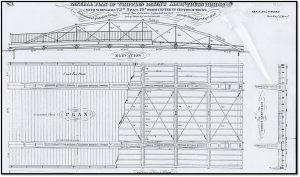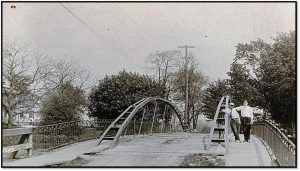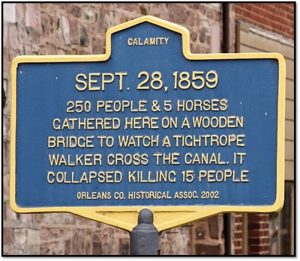Squire Whipple (STRUCTURE, September 2005, January 2015) built one of his early bowstring iron trusses over the Enlarged Erie Canal in Albion, New York, in 1848. He wrote of his early bridges: “About the same period (1840), my own attention was directed to the subject of iron bridges, and I designed the plan of my Patent Iron Trussed Bridge, patented 1841, and built an experimental bridge of 72 feet span, subsequently erected and now in use on the Erie Canal at Newville near Rome. I had, however, in the winter of 1841-42 previous to the erection of the above bridge on the canal, built a bridge of about 80 feet on First Street in Utica, which is the oldest iron bridge now in use on the canal; Trumbull’s first bridge, built a few months sooner than mine, having failed and been rebuilt since, as before stated.”
“Soon after, this work of enlargement was suspended, but little progress was made in the introduction of iron bridges on the canal for several years. In the meantime, I frequently urged on the Canal Commissioners the policy of having a few iron bridges built, for the purpose of more thoroughly testing their economy, that on the resumption of the enlargement, sufficient knowledge might be had for judging accurately as to the expediency of a more extensive adoption of them for the use of the canal. But it was a subject that could bear putting off.
In the spring of 1848, commissioner Hinds, with a discriminating liberality highly creditable, contracted with me for building an iron bridge at the village of Albion and also one at Holley.”
The cost for both bridges was $3,196. The Albion bridge served well until 1859 when it was decided to replace it. It had been raised and set on wood blocks on the west side. One of the men who built the bridge stated, “that through the neglect of the state authorities it had been in an unsafe condition for over a year, and that within a few days he had noticed a decided vertical inclination, and spoken of it. Had proper care been taken in underpinning the bridge when raised, and in examining the structure, tightening or loosening the various bolts as circumstances required, the sad calamity would never have happened.”
The Orleans County Fair had opened about a half-mile from the bridge, and the village was filled with residents and visitors. A young man from Brockport stretched a rope between two buildings, the Mansion House and the Pierpont Dryer’s, on opposite sides of the canal and on the west side of the bridge. He advertised that he would walk the rope across the canal at 5:00 PM, so a large crowd gathered at the bridge to witness the feat. The following newspaper account, one of many, described the collapse:
“The iron bridge near the rope was crowded with people on foot and in wagons, the place being one of the best that could be found for a view of the rope, When the rope walker was just walking out, and all eyes were fixed upon him, the bridge went down with a crash, carrying into the water in a promiscuous mass hundreds of people, including all ages and both sexes, and with them, of course, fell the horse and wagons, iron timbers and other materials of the bridge.
It appears that the largest number of people were on the west side of the bridge, that being nearest to the rope, and that went down first, thus giving the falling mass of human beings and materials a sidewise as well as a downward motion. The eastern section of the bridge falling last must have buried many beneath its ruins. As the bridge was of iron, partly cast and partly wrought, it broke into sections and fragments and went to the bottom of the canal, burying, of course, everything that went before its weight. The excitement which followed cannot be described – it may perhaps be imagined…There were three teams upon the bridge, two carriages and a lumber team. The number of persons on the bridge is estimated at two to four hundred, most of whom went into the water…The bridge was constructed about ten years ago, we think on the Whipple plan. It was about 60 feet long but not the full width of the enlarged canal. It was shortly to be replaced by a larger and better one, the materials for which were already at Albion. It is safe to assume that there was a defect in this structure, or that it has been neglected. These iron bridges require attention, and at times the rods and bolts require to be adjusted so that the weight will be equally distributed. When they are in order, they will sustain any number of human beings that can find a place to stand upon them.”
Another account stated,
“At 5:15, the gymnast began his walk but had not advanced more than ten feet when an ominous creaking and groaning of the bridge was heard, and immediately a man was seen to leap far out into the water. The ropewalker threw him his balancing pole and then dropped down into a sitting posture upon the rope, in which position he remained until the worst was over when he regained his starting place in safety. This passed in a moment. In the next, the foot walk gave way under the pressure and was immediately followed by the remainder of the structure, carrying with it into the water about 500 persons, of whom a considerable number were forced under the remains.”
And another,
“The rope was about two rods west of Main street bridge, an iron arched structure like most of the new canal bridges, which of course offered an eligible standpoint from which to view the performance. It was accordingly crowded with people and teams. The rope walker had got partway across the canal, when the bridge broke in two at the centre, precipitating all who were upon it into the middle of the canal. Men, women, children, horses and wagons, were all piled in an indiscriminate mass. The west half of the bridge went down first, and of course many of those who stood near the break were pitched off in such a way that when the east half of the bridge came down, which it did immediately, it fell upon and covered them up. Mr. Grant informs us that a pair of horses and a carriage full of people were crushed in this way so completely that nothing had been found of them…All eyes were immediately turned from the dexterity of the ropewalker to attend the call of suffering humanity. Very many were in a few moments rescued from the canal, but the falling structure wounded many probably who never rose to the surface again.”
A total of 14 were killed and many injured. An eight-man coroner’s inquest was held on the next day and determined,
“And the jurors aforesaid, upon their oaths aforesaid, do further say that the aforesaid bridge, by reason of the raising thereof, and the placing of same upon blocks of wood, though sufficiently safe for ordinary use, had become unsafe and dangerous upon occasions, calling extraordinary numbers of people upon it, and by the neglect of the officers and persons having charges thereof, had so been suffered to remain for a long space of time, to wit, for three months past.”
They went on to condemn rope-walking, stating,
“The jury are therefore of opinion that the calamity cannot be justly attributed to the neglect of the authorities of the village; but that it is the legitimate fruit of tolerating these pernicious exhibitions in the country, and the jury takes this occasion to solemnly condemn the rope walking exhibitions now and lately so prevalent in the country, as injurious to the public morals, dangerous to human life, and productive of evil only.”
Whipple did not testify and was not found liable. Usually, juries such as this called in experts to testify as to why the bridge failed. Why they did not, in this case, is unknown. The bridge was rebuilt and eventually replaced with a swing bridge that lasted until 1912.
The 1859 Annual Report of the State Engineer and Surveyor stated,
“Said bridge was erected some ten years ago and was of the same style and pattern as several, erected at other places at about the same time, which are yet standing. The sectional area of its sustaining rods was sufficiently great, if sound, to have supported more than four times the load supposed to have been upon that part of the bridge which first gave way when it fell. This being the case, its failure can only be accounted for upon the ground that some of the rods were defective but had escaped previous observation.”
It is clear, therefore, that the bridge was poorly maintained, according to the locals, and poorly inspected, according to the State Engineer. Why it was in the process of being replaced is not known.
Whipple usually designed his bridges to carry 100 psf uniformly spread across the sidewalks and roadway. In this case, the load was very unevenly distributed with the cantilevered sidewalk breaking first and west truss following. The same thing, unbalanced loading, had happened on a wooden bridge he designed to cross the Mohawk River at Cohoes to carry both carriage traffic and a cantilevered towpath for the Champlain Canal. The bridge did not fail but was significantly criticized by the citizens of Cohoes and Waterford. It was destroyed in a fire and replaced with an iron bridge.
When the Enlargement was considered complete in 1862, a survey of the bridges reported that, of the 158 iron bridges, 116 were of the Whipple Bowstring style indicating that the failure of the Albion Bridge did not deter the Canal Commissioners from adopting the Bowstring as their standard iron bridge. Many bridges survived until the New York State Barge Canal replaced the Erie Canal in the second decade of the 20th century and the old canal was filled in. Many bridges were removed at the time and rebuilt elsewhere in New York State. The author has restored bowstrings at Union College, Boonville, and Vischer’s Ferry, and is working on a two-span Whipple Bridge at Claverack, all of which are in New York State.■



